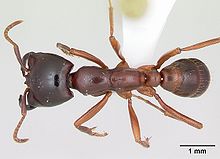| Dorylus | |
|---|---|

| |
| Dorylus gribodoi | |
| Scientific classification | |
| Domain: | Eukaryota |
| Kingdom: | Animalia |
| Phylum: | Arthropoda |
| Class: | Insecta |
| Order: | Hymenoptera |
| Family: | Formicidae Leach, 1815 |
| Subfamily: | Dorylinae Leach, 1815 |
| Genus: | Dorylus Fabricius, 1793 |
| Type species | |
| Vespa helvola | |
| Diversity[1] | |
| 61 species | |
| Synonyms | |
|
Cosmaecetes Spinola, 1851 | |
Dorylus, also known as driver ants, safari ants, or siafu, is a large genus of army ants found primarily in central and east Africa, although the range also extends to southern Africa and tropical Asia. The term siafu is a loanword from Swahili,[2] and is one of numerous similar words from regional Bantu languages used by indigenous peoples to describe various species of these ants. Unlike the New World members of the former subfamily Ecitoninae (now Dorylinae), members of this genus form temporary subterranean bivouacs in underground cavities which they excavate and inhabit - either for a few days or up to three months. Also, unlike some New World army ants, driver ants are not specialized predators of other species of ant, instead being more generalistic with a diet consisting of a diversity of arthropods. Their colonies are enormous compared to other ant species, and can contain over 20 million individuals. As with their American counterparts, workers exhibit caste polymorphism with the soldiers having particularly large heads that power their scissor-like mandibles. They are capable of stinging, but very rarely do so, relying instead on their powerful shearing jaws. A large part of their diet consists of earthworms. [3] Driver ant queens are the largest living ants known, with the largest measuring between 40 - 63 millimeters (1.5 - 2.4 inches) in total body length depending on their physiological condition.[4]
- ^ Bolton, B. (2014). "Dorylus". AntCat. Retrieved 17 July 2014.
- ^ Swahili translation Archived July 20, 2011, at the Wayback Machine
- ^ Hölldobler, Bert; Wilson, Edward O. (1990). The Ants. Belknap Press of Harvard University Press. ISBN 0-674-04075-9.
- ^ Kronauer, Daniel (2020). Army Ants Nature's Ultimate Social Hunters. Cambridge, Massachusetts: Harvard University Press. p. 237. ISBN 978-0-674-24155-8.